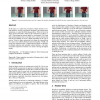Free Online Productivity Tools
i2Speak
i2Symbol
i2OCR
iTex2Img
iWeb2Print
iWeb2Shot
i2Type
iPdf2Split
iPdf2Merge
i2Bopomofo
i2Arabic
i2Style
i2Image
i2PDF
iLatex2Rtf
Sci2ools
APGV
2010
ACM
2010
ACM
The perception of finger motions
In this paper, we explore the perception of finger motions of virtual characters. In three experiments, designed to investigate finger animations, we asked the following questions: When are errors in finger motion noticeable? What are the consequences of these errors? What animation method should we recommend? We found that synchronization errors of as little as 0.1s can be detected, but that the perceptibility of errors is highly dependent on the type of motion. Errors in finger animations can change the interpretation of a scene even without altering its perceived quality. Finally, out of the four conditions tested – original motion capture, no motions, keyframed animation and randomly selected motions – the original motion captured movements were rated as having the highest quality. CR Categories: I.3.7 [Computer Graphics]: Three-Dimensional Graphics and Realism—Animation
| Added | 15 Aug 2010 |
| Updated | 15 Aug 2010 |
| Type | Conference |
| Year | 2010 |
| Where | APGV |
| Authors | Sophie Jörg, Jessica K. Hodgins, Carol O'Sullivan |
Comments (0)

